Healing Performance of a Self-Healing Protective Coating According to Damage Width
Abstract
1. Introduction
2. Materials and Methods
2.1. Materials
2.2. Instruments
2.3. Microencapsulation of Linseed Oil
2.4. Preparation of Coating Samples
2.5. Water Sorptivity Test
2.6. Determination of Healing Efficiency
2.7. Accelerated Carbonation Test
2.8. Chloride Ion Penetration Test
3. Results and Discussion
3.1. Microcapsules
3.2. Water Sorptivity Test
3.2.1. Water Sorptivity According to Damage Width and Capsule-loading
3.2.2. Water Sorptivity According to Damage Width and Microcapsule Size
3.2.3. Water Sorptivity According to Damage Width and Undercoating Thickness
3.3. Other Performances of the Self-Healing Coating with Damage Width of 300 µm
4. Conclusions
Author Contributions
Funding
Acknowledgments
Conflicts of Interest
References
- Wei, H.; Wang, Y.; Guo, J.; Shen, N.Z.; Jiang, D.; Zhang, X.; Yan, X.; Zhu, J.; Wang, Q.; Shao, L.; et al. Advanced micro/nanocapsules for self-healing smart anticorrosion coatings. J. Mater. Chem. A 2015, 3, 469–480. [Google Scholar] [CrossRef]
- Samadzadeh, M.; Boura, S.H.; Peikan, M.; Kasiriha, S.M.; Ashrafi, A. A review on self-healing coatings based on micro/nanocapsules. Prog. Org. Coat. 2010, 68, 159–164. [Google Scholar] [CrossRef]
- Shchukin, D.G. Container-based multifunctional self-healing polymer coatings. Polym. Chem. 2013, 4, 4871–4877. [Google Scholar] [CrossRef]
- Hia, L.L.; Vahedi, V.; Pasbakhsh, P. Self-Healing Polymer Composites: Prospects, Challenges, and Applications. Polym. Rev. 2016, 56, 225–261. [Google Scholar] [CrossRef]
- Blaiszik, B.J.; Kramer, S.L.B.; Olugebefola, S.C.; Moore, J.S.; Sottos, N.R.; White, S.R. Self-Healing Polymers and Composites. Annu. Rev. Mater. Res. 2010, 40, 179–211. [Google Scholar] [CrossRef]
- An, S.; Lee, M.W.; Yarin, A.L.; Yoon, S.S. A review on corrosion-protective extrinsic self-healing: Comparison of microcapsule-based systems and those based on core-shell vascular networks. Chem. Eng. J. 2018, 2018. 344, 206–220. [Google Scholar] [CrossRef]
- Song, Y.-K.; Chung, C.-M. Repeatable self-healing of a microcapsule-type protective coating. Polym. Chem. 2013, 4, 4940–4947. [Google Scholar] [CrossRef]
- Song, Y.-K.; Jo, Y.-H.; Lim, Y.-J.; Cho, S.-Y.; Yu, H.C.; Ryu, B.-C.; Lee, S.-I.; Chung, C.-M. Sunlight-induced self-healing of a microcapsule-type protective coating. ACS Appl. Mater. Interfaces 2013, 5, 1378–1384. [Google Scholar] [CrossRef] [PubMed]
- Guo, W.; Jia, Y.; Tian, K.; Xu, Z.; Jiao, J.; Li, R.; Wu, Y.; Cao, L.; Wang, H. UV-triggered self-healing of a single robust SiO2 microcapsule based on cationic polymerization for potential application in aerospace coatings. ACS Appl. Mater. Interfaces 2016, 8, 21046–21054. [Google Scholar] [CrossRef] [PubMed]
- Kim, D.-M.; Song, I.-H.; Choi, J.-Y.; Jin, S.-W.; Nam, K.-N.; Chung, C.-M. Self-healing coatings based on linseed-oil-loaded microcapsule for protection of cementitious materials. Coatings 2018, 8, 404. [Google Scholar] [CrossRef]
- Boura, S.H.; Peikari, M.; Ashrafi, A.; Samadzadeh, M. Self-healing ability and adhesion strength of capsule embedded coatings-micro and nano sized capsules containing linseed oil. Prog. Org. Coat. 2012, 75, 292–300. [Google Scholar] [CrossRef]
- Wang, H.; Zhou, Q. Evaluation and failure analysis of linseed oil encapsulated self-healing anticorrosive coating. Prog. Org. Coat. 2018, 118, 108–115. [Google Scholar] [CrossRef]
- Behzadnasab, M.; Mirabedini, S.M.; Esfandeh, M.; Farnood, R.R. Evaluation of corrosion performance of a self-healing epoxy-based coating containing linseed oil-filled microcapsules via electrochemical impedance spectroscopy. Prog. Org. Coat. 2017, 105, 212–224. [Google Scholar] [CrossRef]
- Zhao, Y.; Zhang, W.; Liao, L.; Wang, S.; Li, W. Self-healing coatings containing microcapsule. Appl. Surf. Sci. 2012, 258, 1915–1918. [Google Scholar] [CrossRef]
- Kim, D.-M.; Yu, H.-C.; Yang, H.-I.; Cho, Y.-J.; Lee, K.-M.; Chung, C.-M. Microcapsule-type self-healing protective coatings for cementitious composites with secondary crack preventing ability. Materials 2017, 10, 114. [Google Scholar] [CrossRef] [PubMed]
- Wang, W.; Xu, L.; Sun, H.; Li, X.; Zhao, S.; Zhang, W. Spatial resolution comparison of AC-SECM with SECM and their characterization of self-healing performance of hexamethylene diisocyanate trimer microcapsule coatings. J. Mater. Chem. 2015, 3, 5599–5607. [Google Scholar] [CrossRef]
- Attaei, M.; Vale, M.; Shakoor, A.; Kahraman, R.; Montemor, F.; Marques, A.C. Hybrid shell microcapsules containing isophorone diisocyanate with high thermal and chemical stability for autonomous self-healing of epoxy coatings. J. Appl. Polym. Sci. 2020, 137, 48751. [Google Scholar] [CrossRef]
- Cui, J.; Li, X.; Pei, Z.; Pei, Y. A long-term stable and environmental friendly self-healing coating with polyaniline/sodium alginate microcapsule structure for corrosion protection of water-delivery pipelines. Chem. Eng. J. 2019, 358, 379–388. [Google Scholar] [CrossRef]
- Yamuna, J.; Siva, T.; Kumari, S.S.; Sathiyanarayanan, S. A smart poly(aniline-formaldehyde) microcapsule based self-healing anticorrosive coating. RCS Adv. 2016, 6, 79–86. [Google Scholar] [CrossRef]
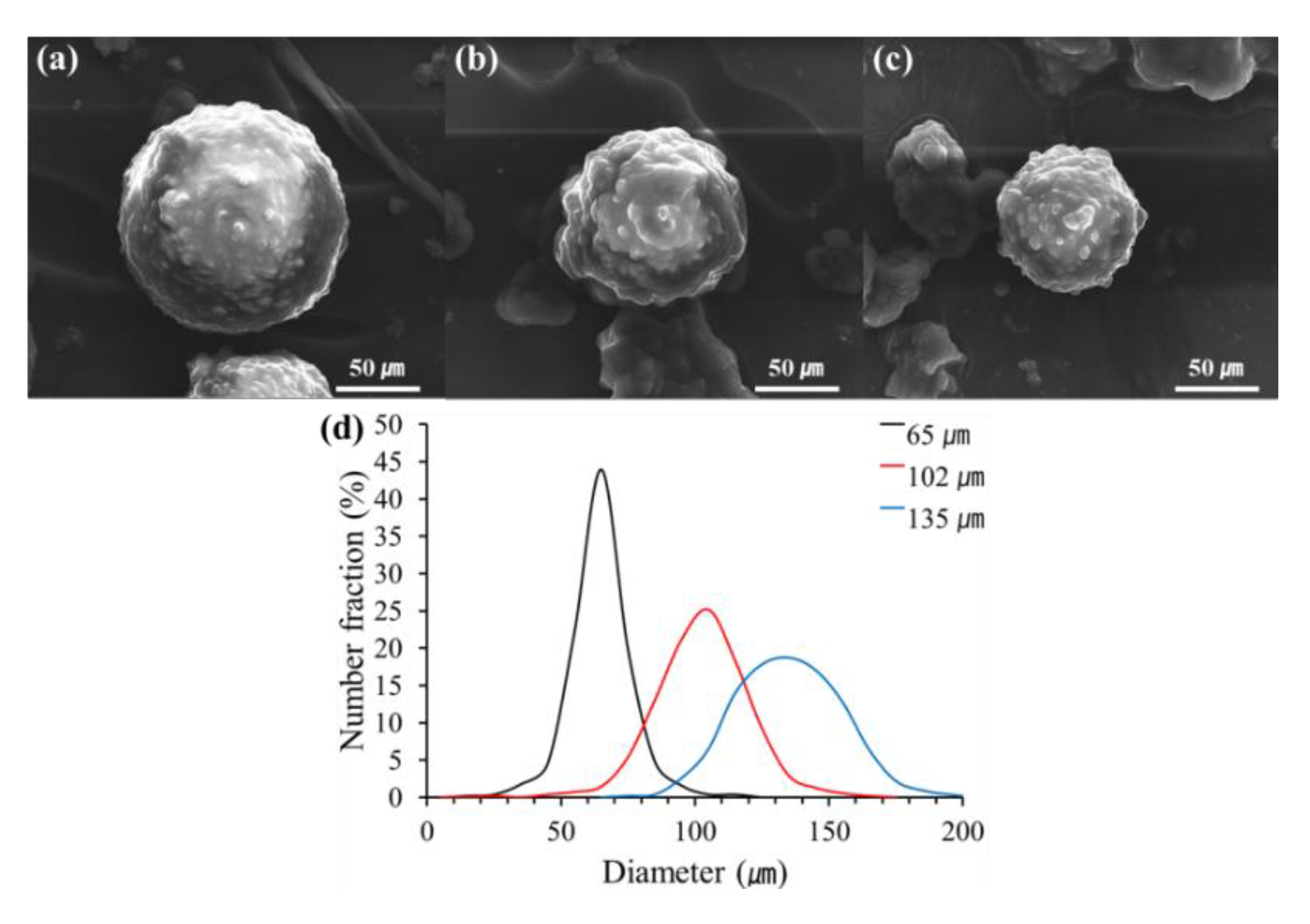
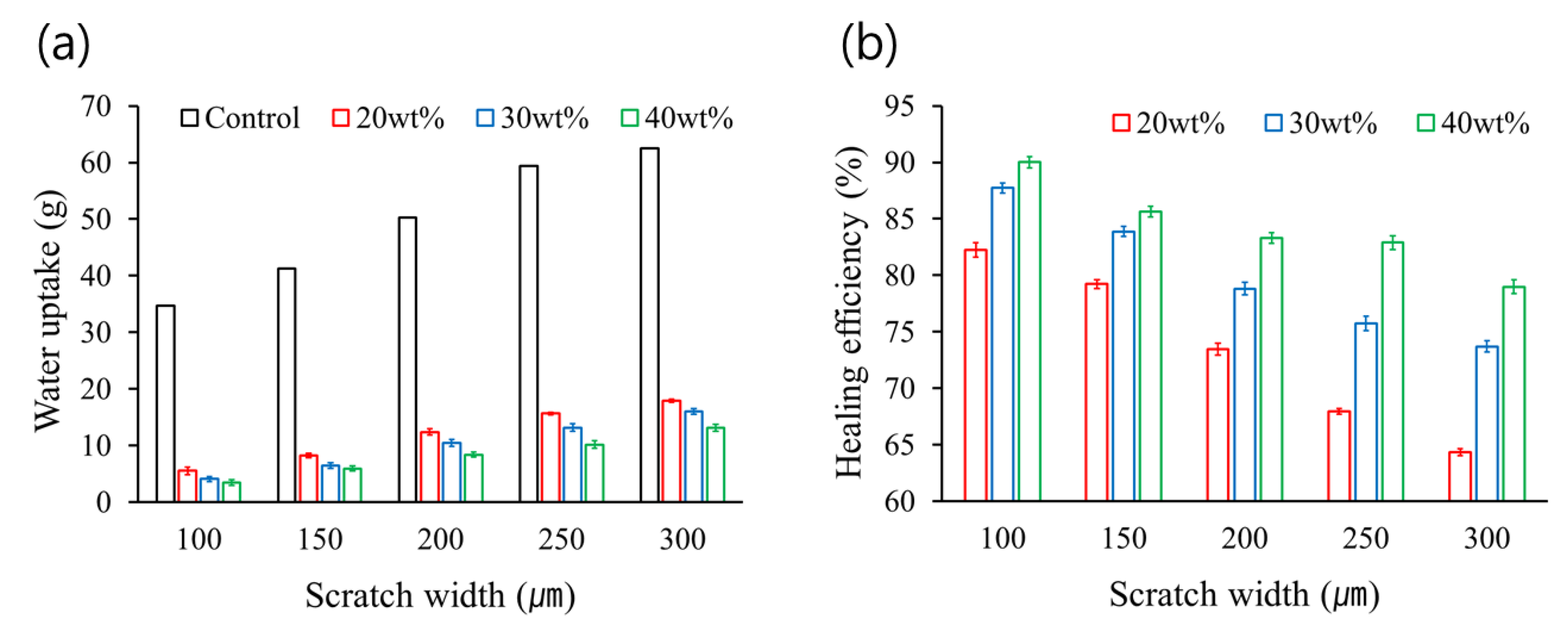

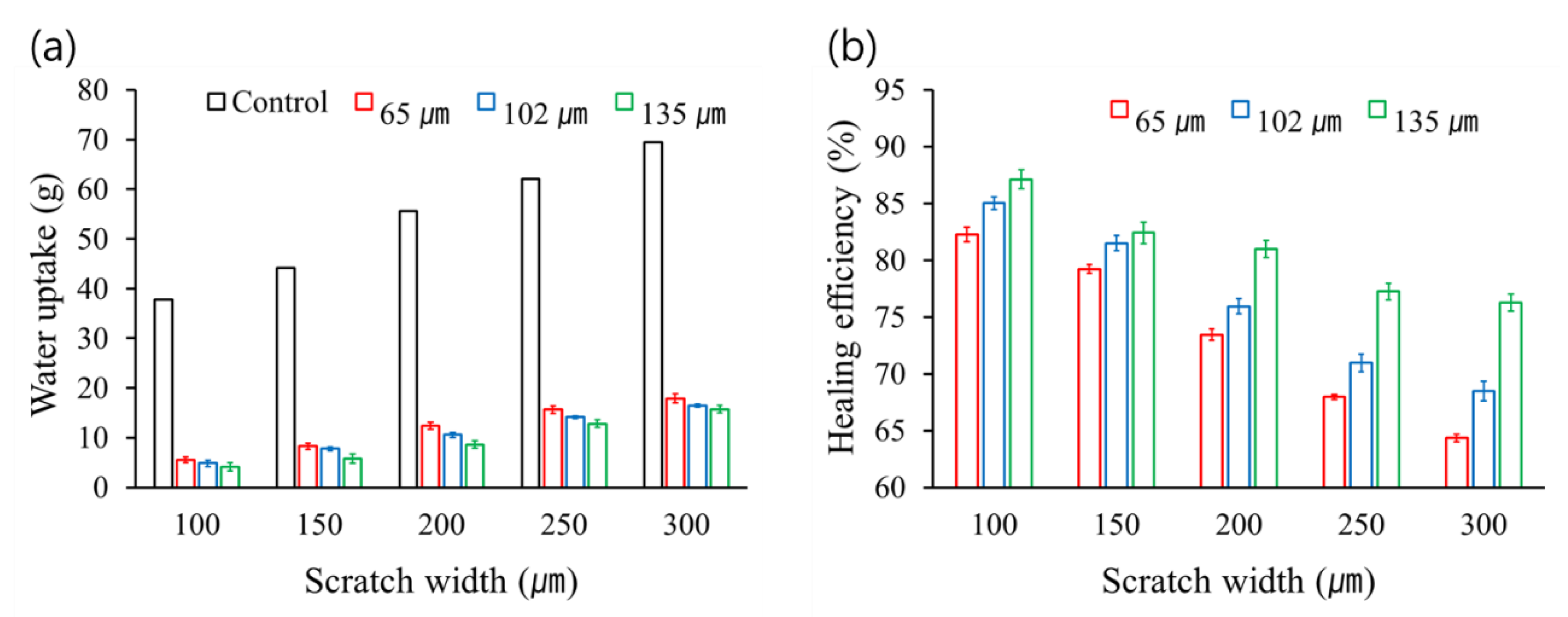
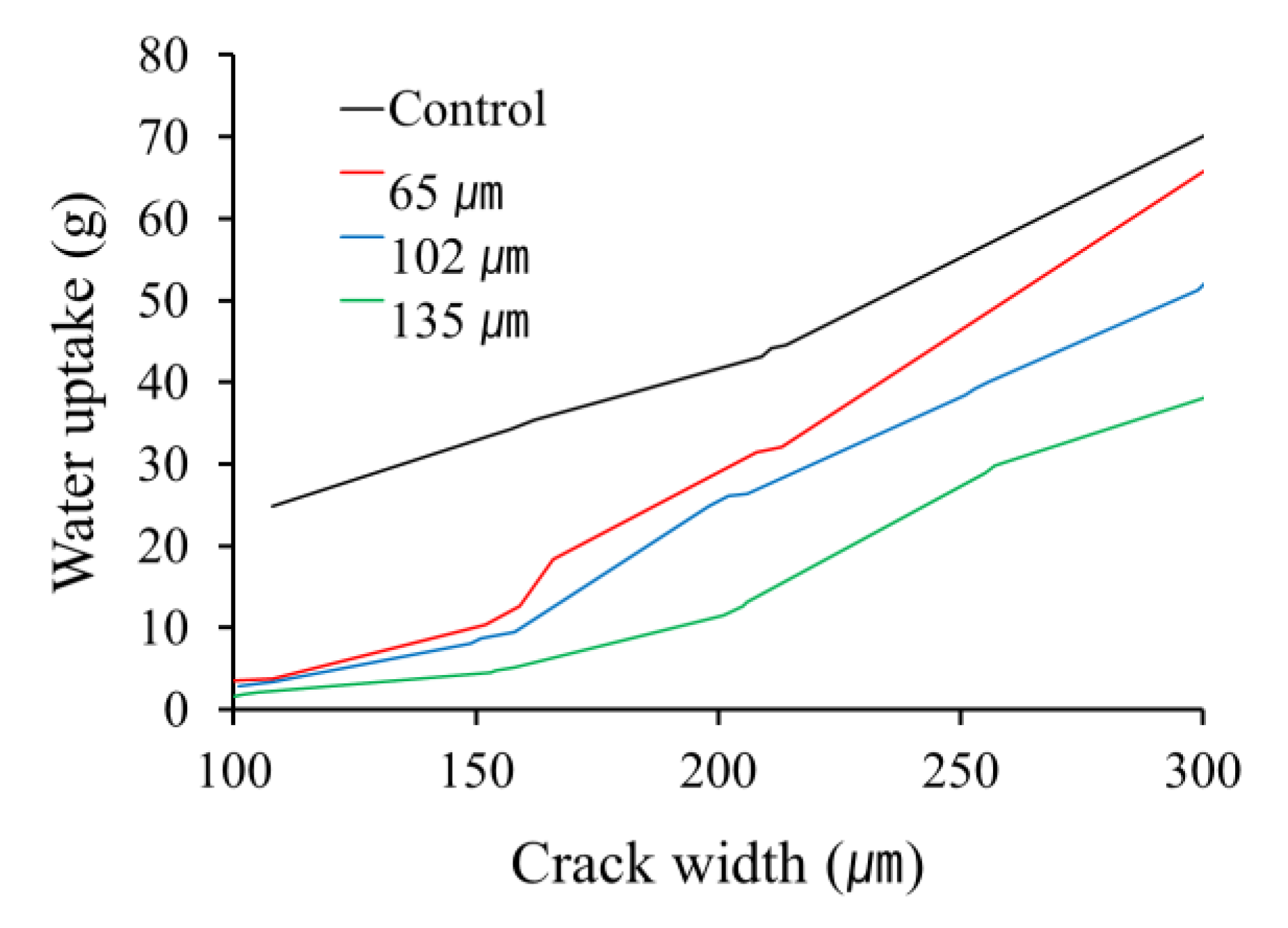
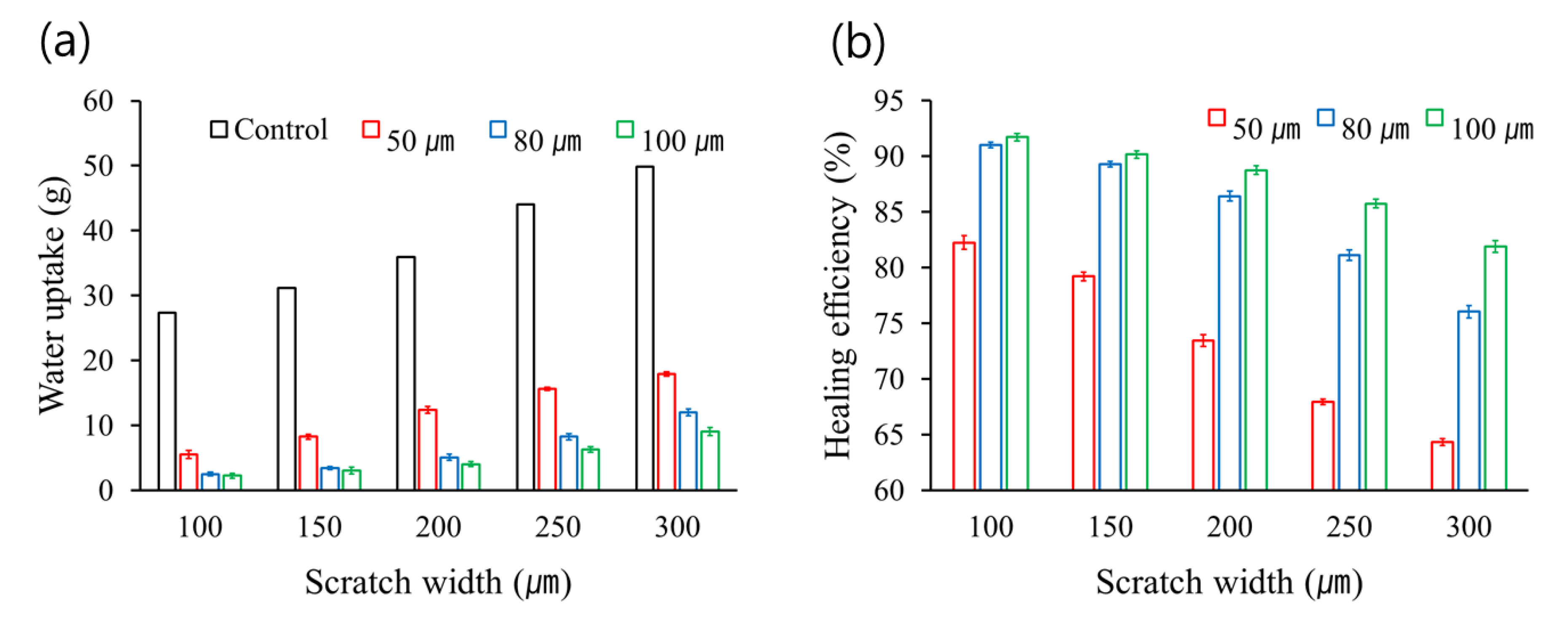

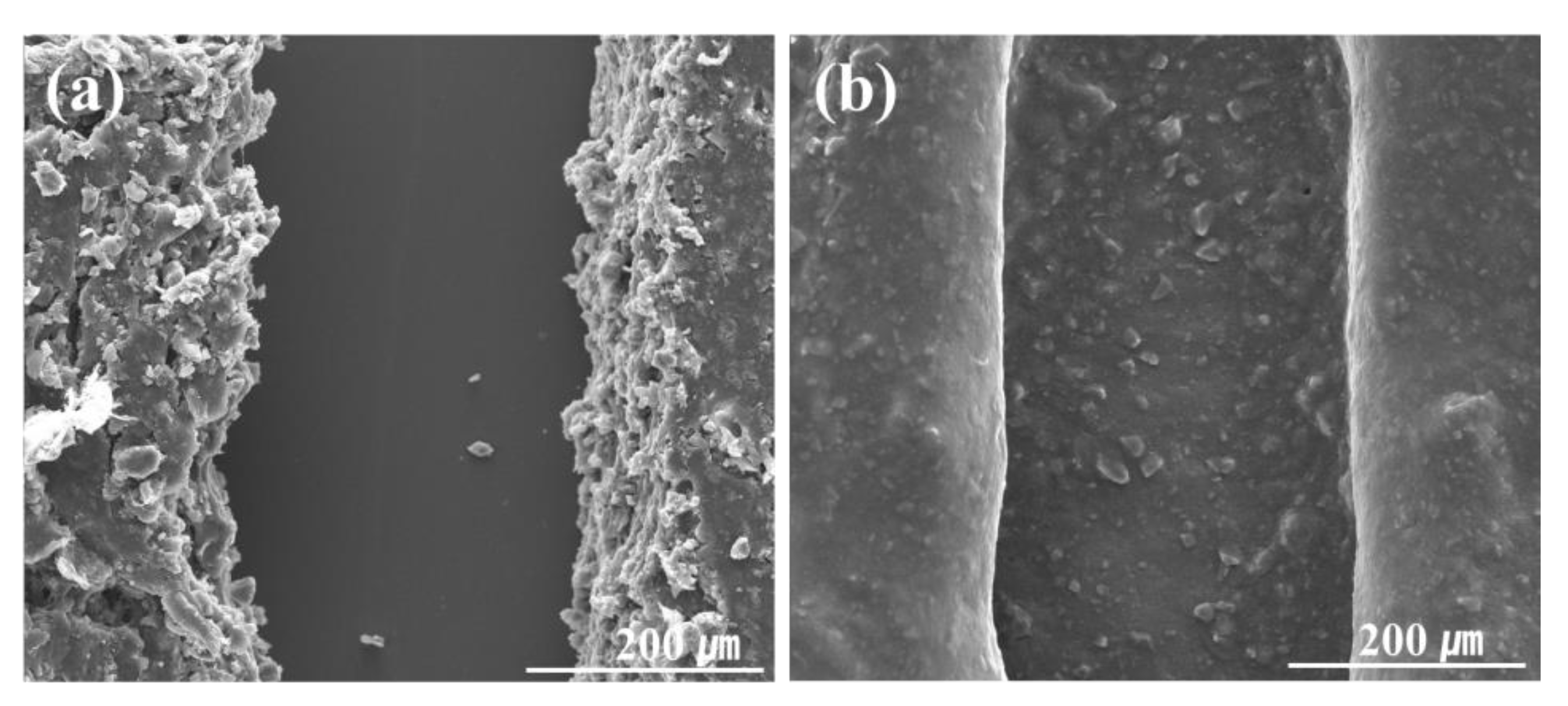
| Variable Parameter | Parameter Value |
|---|---|
| Microcapsule-loading (wt%) | 20, 30, 40 |
| Mean diameter of microcapsules (µm) | 65, 102, 135 |
| Undercoating thickness (µm) | 50, 80, 100 |
| Scratch width (µm) | 100, 150, 200, 250, 300 |
| Crack width (µm) | 95–105, 145–155, 195–205, 245–255, 295–305 |
© 2020 by the authors. Licensee MDPI, Basel, Switzerland. This article is an open access article distributed under the terms and conditions of the Creative Commons Attribution (CC BY) license (http://creativecommons.org/licenses/by/4.0/).
Share and Cite
Kim, D.-M.; Lee, J.; Choi, J.-Y.; Jin, S.-W.; Nam, K.-N.; Park, H.-J.; Lee, S.-H.; Chung, C.-M. Healing Performance of a Self-Healing Protective Coating According to Damage Width. Coatings 2020, 10, 543. https://doi.org/10.3390/coatings10060543
Kim D-M, Lee J, Choi J-Y, Jin S-W, Nam K-N, Park H-J, Lee S-H, Chung C-M. Healing Performance of a Self-Healing Protective Coating According to Damage Width. Coatings. 2020; 10(6):543. https://doi.org/10.3390/coatings10060543
Chicago/Turabian StyleKim, Dong-Min, Junseo Lee, Ju-Young Choi, Seung-Won Jin, Kyeong-Nam Nam, Hyeong-Ju Park, Seung-Hyun Lee, and Chan-Moon Chung. 2020. "Healing Performance of a Self-Healing Protective Coating According to Damage Width" Coatings 10, no. 6: 543. https://doi.org/10.3390/coatings10060543
APA StyleKim, D.-M., Lee, J., Choi, J.-Y., Jin, S.-W., Nam, K.-N., Park, H.-J., Lee, S.-H., & Chung, C.-M. (2020). Healing Performance of a Self-Healing Protective Coating According to Damage Width. Coatings, 10(6), 543. https://doi.org/10.3390/coatings10060543






